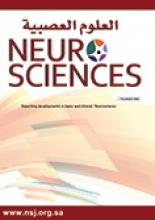To the Editor
We have read with interest the recent findings by Zafar et al.1 The results of the DAWN2 and DEFUSE 33 trials revealed favourable outcomes in patients receiving thrombectomy for acute ischaemic strokes presenting beyond 6 hours and up to 24 hours. How this translates to the management of acute stroke in Kingdom of Saudi Arabia is yet to be elucidated. However, to continue advancing stroke management, efforts ought to focus on 3 key areas.
First, is extending the “thrombectomy-eligibility” to periods beyond 16-24 hours. The literature shows that patients presenting after 16 hours are aplenty-the median time-to-presentation in one study was 16 hours and 5 minutes.4 While such “late presenters” may arguably have less severe strokes, it is conceivable that a proportion of thrombectomy-eligible patients may “miss out” by the time they are transferred to a thrombectomy-capable hospital. This is especially pertinent with the expected logistical challenges in Kingdom of Saudi Arabia.
Second, is enrolling patients with larger ischaemic cores if the associated salvageable penumbra is “substantial. Compared with DAWNs ischaemic cores (≤50 mL),2 those of DEFUSE 33 were more voluminous (up to 70 mL) with no appreciable detriment to patient outcomes. However, there have to be precautions about the difficulties with which such volumes are measured accurately, reliably, and reproducibly.
Finally, the armamentarium with which ischaemic strokes are acutely treated warrants re-evaluation. This includes the safety of using Tenecteplase beyond 4.5 hours, as well as the use of “neuroprotectants” which may further enhance penumbral survival and/or extend thrombectomy-eligibility periods.5
Reply from the Author
We are thankful to Dr. Yassar Alamri for reading our article,1 and giving his valuable suggestions to improve care of patients with acute ischemic stroke.
In fact, year 2018 had many advanced researches in stroke including extending therapeutic window for recanalization therapy in acute ischemic stroke, as mentioned by Dr. Yassar and debating the use of antiplatelet medications for secondary prevention in POINT trial.6,7 Stimulation of sphenopalatine ganglion has also been discussed in the World stroke congress as a reperfusion approach to augment blood flow in collaterals around the infarcted area.6
There has been recent advancement in primary prevention as well like using population based strategies such as smoking bans, building healthy cities and individual based strategies such as polypill and Health (namely, the use of mobile phone to improve health care such as app of stroke riskometer).8
Despite being the largest country in Middle East, the Kingdom of Saudi Arabia is lacking standard stroke care in many settings. A study addressing the level of awareness in Saudi population observed an alarming deficit in it.9 The benefits from these advancement in stroke care and prevention strategies can only be availed if proper stroke care programs are launched at regional and national levels.
Azra Zafar,
Department of Neurology, College of Medicine Imam Abdulrahman Bin Faisal University, Dammam, Kingdom of Saudi Arabia
- Copyright: © Neurosciences
Neurosciences is an Open Access journal and articles published are distributed under the terms of the Creative Commons Attribution-NonCommercial License (CC BY-NC). Readers may copy, distribute, and display the work for non-commercial purposes with the proper citation of the original work.






